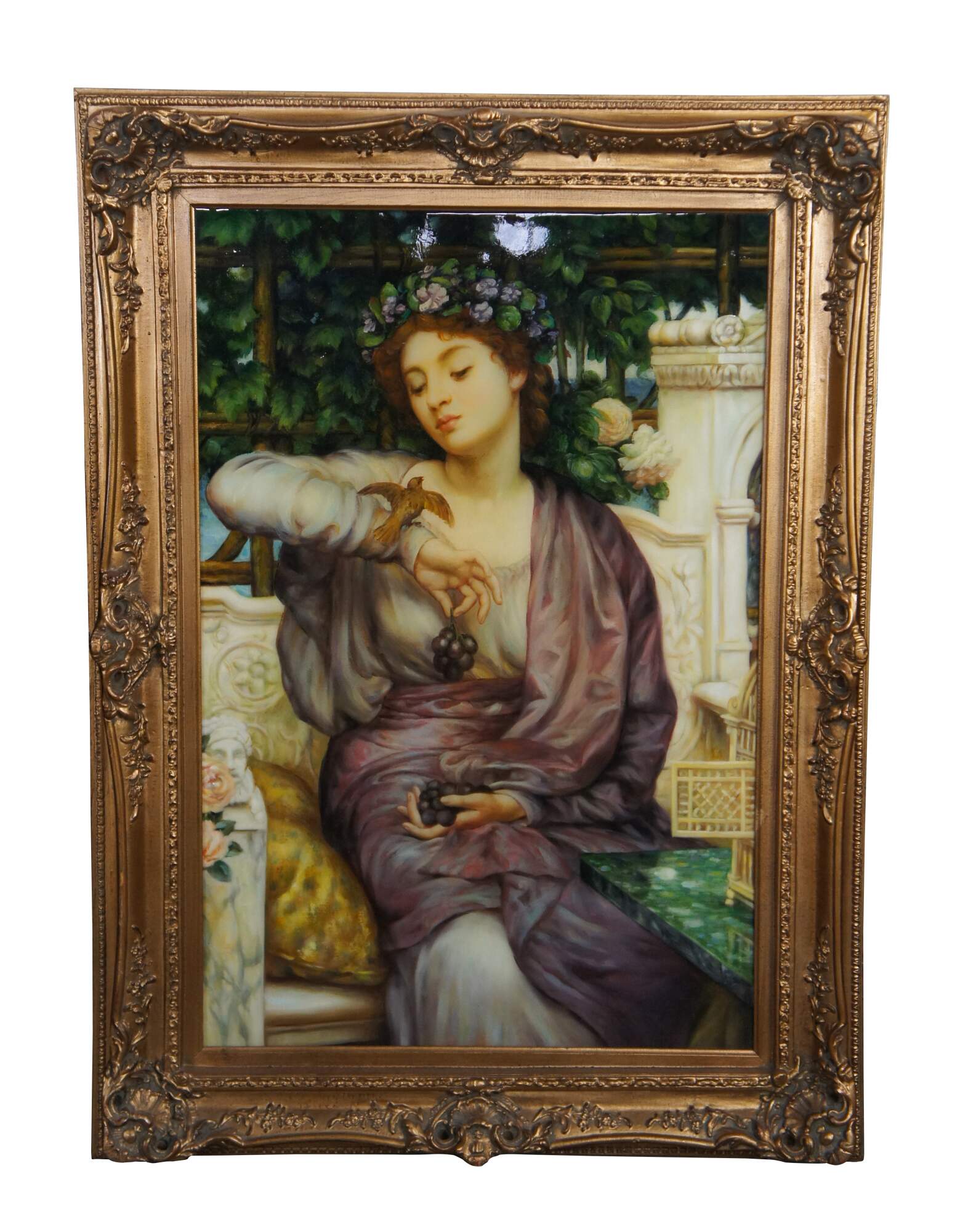
Shipping:
Free Shipping Included
Delivery:
Estimated 2-15 Business Days
Payments:
Credit Card, Check, Cash, PayPal, Apple Pay, Venmo
Returns:
30 Days 100% Money Back Guarantee, Buyer Pays Return Shipping
Description
Vintage Lesbia and her Sparrow oil painting after Sir Edward John Poynter. It features Lesbia sitting in the courtyard feeding grapes to her sparrow. Oil is painted on canvas and resin-coated. Framed in baroque gold with acanthus and floral accents.
Originally painted in 1907, this portrait subject with its sparrow, a tiny symbol of lust, was in turn admired for its charm and beauty. Before this, British artist’s work sought to celebrate the Neoclassical mythological female figure of Lesbia amidst the aromatic lavenders and purples that symbolized love and fertility and were associated with the Olympian God Zeus. An English Pre-Raphaelite painter, designer, and draughtsman, Victorian Poynter’s classical education paved the way for his prestigious career as President of the Royal Academy and his eventual knighthood.
Sir Edward John Poynter, 1st Baronet GCVO, PRA (20 March 1836 – 26 July 1919) was an English painter, designer, and draughtsman who served as President of the Royal Academy.
Poynter was the son of architect Ambrose Poynter. He was born in Paris, France, though his parents returned to Britain soon after his birth. He was educated at Brighton College and Ipswich School, but left school early for reasons of ill health, spending winters in Madeira and Rome. In 1853, he met Frederick Leighton in Rome, who made a great impression on the 17-year-old Poynter. On his return to London, he studied at Leigh's Academy in Newman Street and the Royal Academy Schools, before going to Paris to study in the studio of the classicist painter Charles Gleyre, where James McNeill Whistler and George du Maurier were fellow students.
In 1866, Poynter married the famous beauty Agnes MacDonald, daughter of the Rev. G. B. MacDonald of Wolverhampton, and they had three children. Her sister Georgiana married the artist Edward Burne-Jones; her sister Alice was the mother of writer Rudyard Kipling; and her sister Louisa was the mother of three-times Prime Minister of the United Kingdom, Stanley Baldwin.
Poynter's sister, Clara Bell, became a noted translator of literary and scientific works.
He became best known for his large historical paintings such as Israel in Egypt (1867; Guildhall Art Gallery, London), followed by St George for England (1869), a mosaic for the Central Lobby of the Palace of Westminster, depicting St George and the Dragon[1] and perhaps culminating with The Visit of the Queen of Sheba to King Solomon (1884–90; Art Gallery of New South Wales, Sydney). He was admitted as an associate of the Royal Academy in 1869.
Poynter held a number of official posts: he was the first Slade Professor at University College London from 1871 to 1875, principal of the National Art Training School from 1875 to 1881, and director of the National Gallery from 1894 to 1904 (overseeing the opening of the Tate Gallery). He became a full Royal Academician in 1876. In 1896, on the death of Sir John Millais, Poynter was elected President of the Academy. He received a knighthood in the same year and an honorary degree from Cambridge University in 1898. It was announced that he would receive a baronetcy in the 1902 Coronation Honours list published on 26 June 1902 for the (subsequently postponed) coronation of King Edward VII, and on 24 July 1902, he was created a Baronet, of Albert Gate, in the city of Westminster, in the county of London.
Poynter's old school, Brighton College, held an exhibition of Poynter's paintings and drawings entitled Life at Arms Length in its Burstow Gallery in November–December 1995.
Condition
Good overall condition, some wear and distressing, resin-coated canvas.
Dimensions
33" x 45", sans 24" x 36"